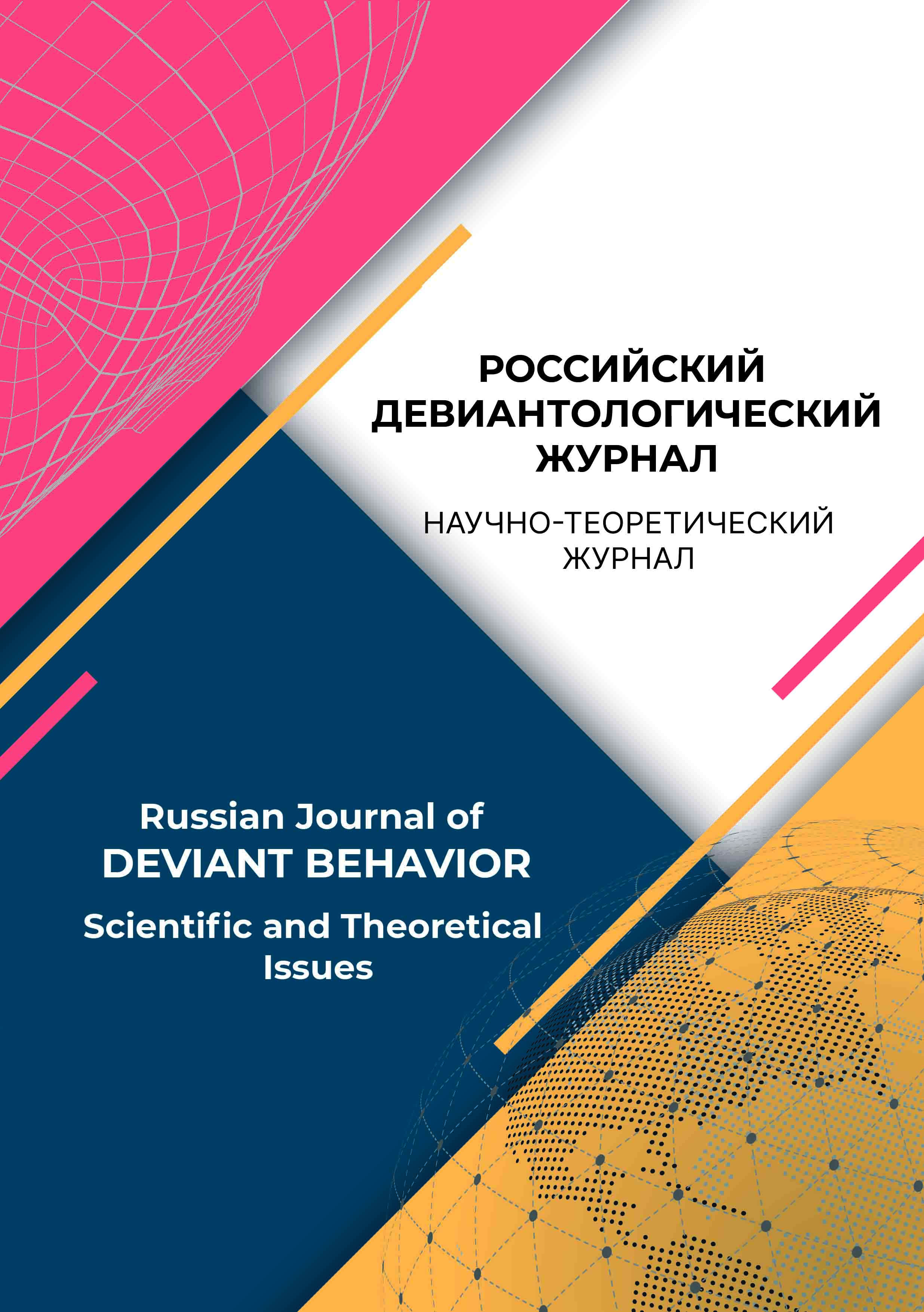Russian Federation
Russian Federation
Introduction. Understanding the grounds of the law-abiding behavior of young people is a socially significant, but poorly studied research domain. Knowledge of the psychological causes of law-abiding behavior is important for the implementation of preventive work with deviant youth and the socialization of the younger generation. Contemporary scientific ideas do not have sufficient information about the role of the entire system of relations of the subject with the social environment for the motivation of law-abiding behavior, focusing on the study of the role of its specific participants - family members, relatives, friends and colleagues. The study is focused on the relations with the social environment as a motive for law-abiding behavior. For this purpose, the study performs a cross-cultural assessment of these relationships in Chinese and Russian youth samples. Methodology, methods and techniques. The methodological basis of the study is the social network approach to the social environment studies. This approach makes it possible to describe the social environment as a quasi-social group, the basis (center) of which is the subject, while the rest of the participants are connected to the subject through social and psychological relations. Application of this approach reveals the significance of the social environment as a motive for law-abiding behavior, showing the effect of relations with the social environment on delinquent behavior readiness. Cross-cultural studies represent the research strategy. Information collecting method is a questionnaire analyzing the social relations and the motives of law-abiding behavior, as well as a standardized self-report measuring the subjective interaction features. Results processing method: descriptive statistics, non-parametric alternative to one-way analysis of variance - Kruskal-Wallis H-test. Survey sample: 100 people, consisted of Russian (50 people) and Chinese (50 people) students, of the similar age and gender. Results: the social environment features have been determined affecting law-abiding behavior and making up motivation: (1) Social environment parameters (volume, homogeneity, interaction difficulties) within the average (standard) values do not affect the law-abiding behavior of young people; (2) Self-assessment of interaction with the social environment enhances the motivation for law-abiding behavior for Russian youth; (3) Social support from individuals in the social environment enhances the motivation for law-abiding behavior in the Russian and Chinese sampling; (4) The system of motives for law-abiding behavior can be represented as emotional, social, personal and rational motives developed under the social environment influence. Scientific Novelty. The data obtained expand the understanding of the motivating role of relationships with the social environment, showing that the help and support of others, as well as self-assessment of interaction with the social environment, enhances the law-abiding behavior motivation. Practical Significance. The represented classification of the motives of law-abiding behavior can be applied to develop procedures for measuring and evaluating the readiness of young people to comply with legal standards.
law-abiding behavior, legal awareness, social monitoring, social relations, social support, self-assessment of interaction
1. Zlokazov, K. V. (2021). Social’noe prostranstvo v predstavlenii prestupnika: monografiya. Saint Petersburg: Sankt-Peterburgskij universitet MVD Rossii.
2. Kirillova, E. B., Shestakov, A. G. (2018). Faktornaya struktura chert lichnosti deviantnyh podrostkov. Vestnik Sankt-Peterburgskogo universiteta MVD Rossii, 4(80), 197-201.
3. Muslumov, R. R. (2019). Problemy formirovaniya pravovogo samosoznaniya lichnosti. Perspektivy nauki i obrazovaniya, 6 (42), 44-54. https://doi.org/10.32744/pse.2019.6.4
4. Purgina, E. S. (2014). Problemy pravovoj kul’tury i “kul’tury legal’nosti” v rabotah S. Silbi. Izvestiya Ural’skogo federal’nogo universiteta. Seriya 3: Obshchestvennye nauki, 3(131), 88-91.
5. Razumova, E. M. (2007). Psihologicheskie osobennosti lichnosti prestupnikov-recidivistov: dis.... kand. psihol. nauk. Saint Petersburg: SPbGU.
6. Troshchinskij, P. V. (2016). K voprosu o tradicionnyh vzglyadah na pravo v kitajskom obshchestve. Vestnik Universiteta imeni O.E. Kutafina, 3, 136-146.
7. Akers, R. L. (2009). Social learning and social structure: A general theory of crime and deviance. New Brunswick, NJ: Trans¬action.
8. Beaver, K. M., Gibson, C. L., Turner, M. G., DeLisi, M., Vaughn, M. G., & Holand, A. (2011). The stability of delinquent peer associations: A biosocial test of Warr’s sticky friends hypothesis. Crime & Delinquency, 57, 907-927.
9. Boman, J. H. IV (2017). Do birds of a feather really flock together? Friendships, self-control similarity and deviant behavior. British Journal of Criminology, 57, 1208-1229.
10. Brisette, I., Cohen, S., & Seeman, T. E. (2000). Measuring social integration and social networks. In S. Cohen, L. G. Underwood, & B. H. Gottlieb (Eds.), Social support measurement and intervention (pp. 53-85). New York: Oxford University Press.
11. Guo, Y., Li, Y., & Ito, N. (2014). Exploring the predicted effect of social networking site use on perceived social capital and psychological well-being of Chinese international students in Japan. Cyberpsychology, Behavior, and Social Networking, 17(1), 52-58.
12. Knecht, A., Snijders, T. A. B., Baerveldt, C., Steglich, C., & Raub, W. (2010). Friendship and delinquency: Selection and influence processes in early adolescence. Social Development, 19, 494-514.
13. Kohlberg, L., Levine, C. & Hewer, A. Moral Stages: A Current Formulation and a Response to Critics (New York: S. Karger, 1983).
14. Kreager, D. A., Schaefer, D. R., Bouchard, M., Haynie, D. L., Wakefield, S., Young, J. T. N., & Zajac, G. (2016). Toward a criminology of inmate networks. Justice Quarterly, 33, 1000-1028.
15. Mattsson, L. & Salmi, A. (2013). The changing role of personal networks during Russian transformation: challenges for Russian management. Journal of Business & Industrial Marketing, 28(3), 190-200.
16. McDonald, S., Chen, F., & Mair, C. A. (2015). Cross-national patterns of social capital accumulation: Network resources and aging in China, Taiwan, and the United States. American Behavioral Scientist, 59(8), 914-930. https://doi. org/10.1177/0002764215580587
17. McGloin J.M. (2009). Delinquency balance: Revisiting peer influence. Criminology, 47, 439-447.
18. Michailova, S., & Worm, V. (2003). Personal Networking in Russia and China. European Management Journal, 21(4), 509-519. https://doi.org/10.1016/s0263-2373(03)00077-x
19. Steinfield, C., Ellison, N. B., & Lampe, C. (2008). Social capital, self-esteem, and use of online social network sites: A longitudinal analysis. Journal of Applied Developmental Psychology, 29(6), 434-445. https://doi.org/10.1016/j. appdev.2008.07.002
20. Turiel, E., Killen, M., & Helwig, C. (1987). Morality: its structure, functions, and vagaries. In J. Kagan, & S. Lamb (Eds.), The emergence of morality in young children (pp. 155-243). Chicago: The University of Chicago Press.

















